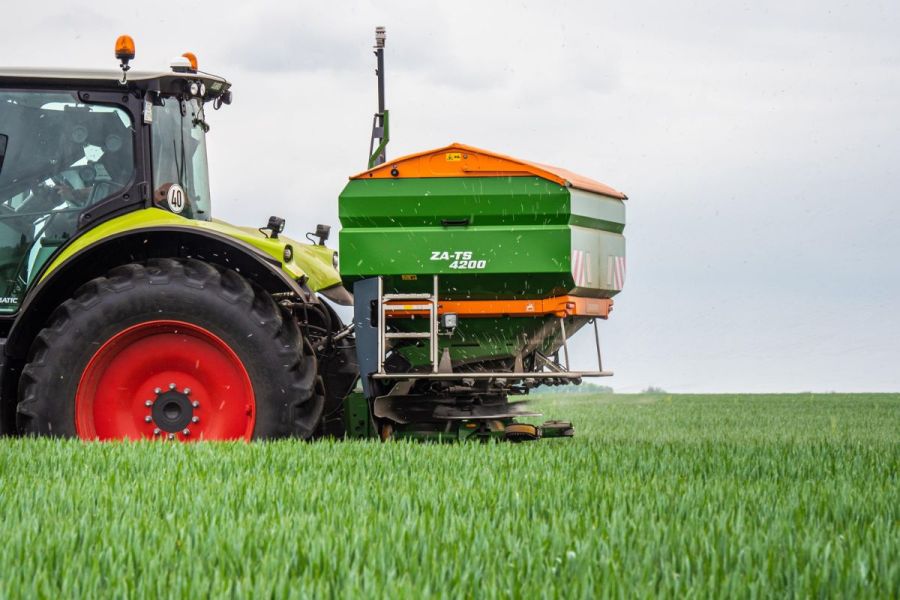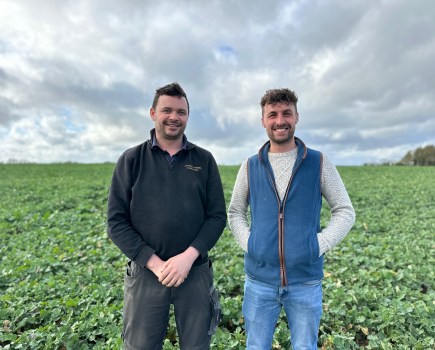High prices, high costs, high accuracy, low impact. These are the key drivers behind fertiliser spreader purchases and are directing the focus of new technology. CPM speaks to the manufacturers to get the low down on market drivers and the latest products.
“Having section control can provide a 5% saving in fertiliser, depending on accuracy.”
By Melanie Jenkins
The extraordinarily high peaks in the cost of fertiliser over the past year have driven farmers to invest more money in their fertiliser spreaders in an effort to optimise accuracy and reduce losses. High end machines are making up the bulk of sales and weigh cells have become the standard, according to manufacturers.
Amazone
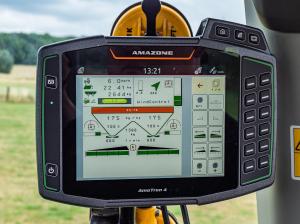
One of Amazone’s latest precision additions to its spreaders is WindControl which senses the direction and strength of the wind.
Fertiliser cost is the most crucial and significant driver in the spreader market at present, according to Amazone’s Simon Brown. “Farmers, therefore, want to maximise the use of anything they’re going to apply, and this will come down to good calibration to make sure they’re putting on the right amount. And more often this is being done by weigh cell rather than by the more traditional bucket method.”
Simon has noticed more customers looking to purchase increasingly technical machines to make cost savings by investing in more precise technology.
He suggests using maps to allow for variable rate applications and then only applying what the crop requires based on factors such as its biomass and nitrogen levels in the leaf.
Variable rate application has been a really positive step for fertiliser application and can now be done as simply as pushing a button, he says. “Often GPS systems can run a map which the machine will react to automatically.”
Similarly, technology has reduced overlaps on the headlands, reducing the likelihood of over-application, he adds.
“The technology available can detect the on/off point far more accurately and reliably than the operator,” explains Simon. “Amazone’s hydraulic drive machines can have up to 128 sections to provide the ultimate number of on/off points. Having section control can provide at least a 5% saving in fertiliser usage, depending on field shape and size.”
Once spreading, machines can use three pieces of information to help improve overall accuracy, he says. “Alongside Section Control which reduces over- and underdosing, the 200 Hz weighing system looks after the overall application rate across the field and is taking 200 weight readings per second to maintain accuracy. ProfisPro, which includes a torque sensor on the drive to each disc ensures an accurate correlation between the quantity being applied from each side of the machine with the desired application rate across all types of fertilisers. The technology constantly senses for issues and automatically adjusts the flow to compensate.”
Further technology, in the form of Amazone’s ArgusTwin system, monitors and oversees the spread pattern constantly and changes it automatically when variations in fertiliser, slope or driving behaviour are detected to bring it back to the set pattern, explains Simon. The system identifies lateral distribution using radar technology which isn’t affected by dust and pollution.
One of the firm’s latest precision additions to its spreaders is WindControl. “This senses the direction and strength of the wind and changes the settings of the spreader to optimise the pattern to compensate.”
Other considerations for users include the accuracy of headland spreading, he adds. “In the past we have done this by using the Limiter border spread deflector, or by altering the disc speed on one side of the machine”. But now – on the top of the range TS spreaders – Amazone’s AutoTS utilises special in-cab actuated headland spreading vanes to give a quick square cut-off as close to the field edge as possible.
“The weak point of any twin disc broadcaster is the headlands and the ins and outs, so we have really concentrated on these with HeadlandControl, AutoTS and now BorderTS,” he explains. “AutoTS can give about 17% more yield than a conventional boundary spreading system but now we have the BorderTS system. This is a deflector that curtails the spread on the one side completely, and which boosts the yield by a further 2-3% in that outer 3-5m around the outside”
Unlike conventional deflectors, the BorderTS system is integrated into the software of the fertiliser spreader. The deflector is used in addition to the disc integrated AutoTS border spreading system and is actuated during an additional pass around the outside of the field, says Simon.
To further help with precision application, Amazone has recently launched its GPS ScenarioControl software. “This allows operators to plot the route of application around the field and automate functions based on this to avoid errors during subsequent applications.”
Amazone has also just revamped its MySpreader app. “We have made it more user friendly and have built in EasyMix to get the best pattern with blended fertilisers and it also includes the EasyCheck spread pattern checking software,” adds Simon.
“For those considering a new spreader, buying a more advanced spreader will typically pay for itself in one to two years, just because it’s able to do more for you.”
KRM
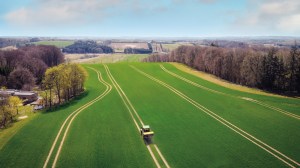
KRM has sold more high-level specification machines as customers opt to prioritise accuracy.
Mike Britton of KRM has noticed a considerable change in the level of specification people are opting for when buying fertiliser spreaders. “We have seen this trend for the past few years, but in this last year it’s been really significant.
“The price of fertiliser has meant we’ve sold a lot more machines with weigh cells and customers are choosing fully automatic and self-operating machines to ensure that correct application is adhered to, come rain, shine or ground condition,” he explains.
“Customers have been opting to include section control, so that in irregular shaped fields they can reduce the spread path on one side, saving on fertiliser and producing more even results. This also makes subsequent chemical applications and combining easier.”
Although section control can be operated manually, Mike believes this is far trickier for the user, whereas set automatically it’s both easier and more accurate. “The inclusion of section control means the value of machines we’ve been selling is quite high, but growers want to get the ultimate level of accuracy.
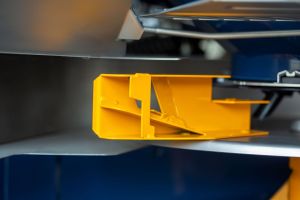
KRM’s new E2 fertiliser spreading veins aim to improve headland performance by providing a more level cutoff and a sharper line at the border.
“When fertiliser was cheaper, there wasn’t as much point spending thousands on a spreader, but now it’s expensive, growers want a machine that can do the job as accurately as possible,” he explains. “And I think they’re also conscious of the environment.”
Mike also feels that more farmers might be opting for lesser quality fertiliser due to pricing and warns this can impact applications. “Be aware that if it’s cheaper, then there’s a reason for that. I would suggest getting your spreader’s tray tested to make sure it will spread to the distance of your tramlines.”
A new addition to KRM’s fertiliser spreader offering includes an updated design for its spreading veins, says Mike. “The new E2 veins aim to improve headland performance by providing a more level cutoff and a sharper line at the border. All new machines come with the E2 veins and anyone ordering replacements will get these too.”
Kuhn
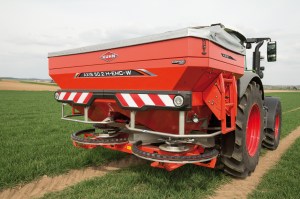
Kuhn has experienced an increase in demand for its Axis 50.2 model.
According to Edd Fanshawe of Kuhn, the firm is seeing an increase in demand for the Axis 50.2 model, especially with the added connectivity that the firm’s new CCI Connect Lite remote view offers. “Being able to track, record and share data between machines is definitely becoming more sought after by contractors and larger farms, so we have also introduced CCI Connect Pro which enables machine data to be accessed and shared using Agrirouter.”
Kuhn’s new higher end models have moved to the CCI Connect services for all ISOBUS terminals, which is all about being able to record and share information.
CCI Connect is now available on all CCI 800 and 1200 terminals to enable operators to receive and send data, connect to Agrirouter machines remotely, and update machinery on the move.
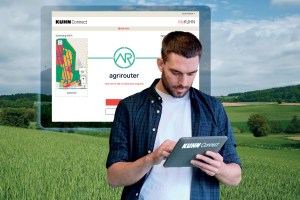
Kuhn’s new higher end models have moved to the CCI Connect services for all ISOBUS terminals.
“These terminals will now be fitted as standard with a wi-fi module. By sharing connected data, operators will be able to use the remote view function to update the CCI terminal and even share data with other machines on the Agrirouter platform,” explains Sian Pritchard of Kuhn.
The new CCI Connect is available in Lite and Pro packages and can be accessed through Kuhn’s existing MyKuhn platform which already allows users to access machine information, source parts and manage tasks. Once connected, operators can permit dealers remote viewing of the machines to enable set up, monitor tasks and provide training.
Updates to the ISOBUS terminal can be made remotely and while the operator is on the move. Additionally, task, telemetry, and map data can also be transferred between terminals and farm management software using Kuhn’s EasyTransfer and the Agrirouter platform.
Lite users will have access to remote view and online updates, while Pro users will be able to use the EasyTransfer system and can integrate with machines on the Agrirouter network.
Kverneland
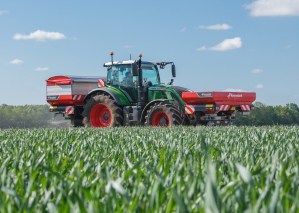
Kverneland’s weigh cell equipped Exacta models can now be used in a front- and rear-mounted disc spreader combination.
According to Graham Owen of Kverneland, the firm has also experienced a notable shift away from smaller machines and a trend towards high end spreaders with weigh cells. “The move away from smaller spreaders may be due to grassland farmers not purchasing new equipment because they’re not putting the same amount of fertiliser on due to its price. Whereas the shift towards high end machines could be farmers trying to optimise the accuracy of the fertiliser they do apply.”
One technology Graham feels could offer farmers increased accuracy when spreading is Kverneland’s Multirate system. “Multirate, which was introduced about three years ago, uses tighter grid sampling and high-resolution maps to provide up to eight sections of variable rate capability across the full working width of the machine.”
However, one of its restricting factors is that Multirate works most effectively when field maps are in 3-5m² grids, so if growers have maps of 20-25m² they might be only getting one or two zones of capacity, explains Graham. “The difficulty with the higher resolution maps is the increased file size which requires bigger processors and some terminals aren’t able to cope yet. So there’s advantages and disadvantages, but given time it will likely get more uptake.”
Kverneland has introduced several new innovations to its disc spreader technology to assist operators with headland management and increased weigh cell utilisation.
The first development is an integrated hydraulic driveline called intelligent Disc Control (iDC). This driveline enables independent disc speed regulation on left- and right-hand discs, to help improve application accuracy. The iDC uses two individually controlled hydraulic motors – one to power each disc, eliminating the need for a mechanical PTO drive, he says.
“With headlands accounting for up to 54% of a field’s total area – the smaller the field, the greater the headland percentage – there is a requirement for enhanced spread pattern control during border spreading. And it’s not just on the headland side, but also in-field when border spreading where the full spread pattern has to be maintained,” explains Graham.
Using a tractor’s Power Beyond capability, iDC can deliver a more consistent disc speed, which is maintained through monitoring, he adds. “Without the constraints of a fixed PTO speed to operate a mechanical driveline, tractor fuel efficiency gains are possible as a result of using much lower engine revs when spreading.” The iDC spreader is priced from £33,150 and is only available only for the Kverneland Exacta TL Geospread model.
Additional spreader developments have been introduced to Kverneland weigh cell equipped Exacta models, enabling the CL, TL and TLX Geospread to be used in a front- and rear-mounted disc spreader combination.
Advancements in the software means that Exacta spreaders equipped with weigh cells are now more easily located as front-mounted implements and can be managed through any universal terminal. “This flexibility can create payloads of up to 7000 litres from combining front- and rear-hopper capacities, and also offers the ability to make two separate applications with different fertiliser products in one pass,” says Graham.
Should the tractor lack a front PTO, all three models can also be equipped with an optional central hydraulic driveline to replace the PTO shaft, he adds. In addition, the ExactLine border spreading device can be specified for mounting on the left- or right-hand side of the spreader, so both machines can manage their border spreading on the same side.
Lemken
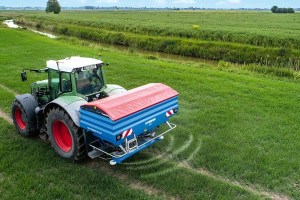
Lemken’s top tier machines, which offer the most advanced technology, are in its Polaris range.
Still relatively new to the fertiliser spreader market, Lemken sells three tiers of Sulky machines under its own colours. “As we feel our way into this market, what we’ve really noticed is the focus of customers turning towards technology,” explains Lemken’s Paul Creasy. “Both UK and Irish farmers are really keen to look at new technology when it comes to spreading fertiliser. There’s a drive to make sure that the fertiliser being used is spread correctly and accurately, so this means keeping shut off and overlaps down to a minimum.”
Owners and operators aren’t just after the accuracy element in the top of the range machines though, according to Paul. “They’re also looking to be more environmentally friendly in their spreading practices. This means not overdosing and accurate spreading around borders and watercourses.
“And operators want a border spreading system that’s easy to use,” he adds. “They don’t want to have to jump out the cab to change the discs but want to be able to make adjustments from the cab.”
The firm’s top tier machines, which offer the most advanced technology, are in its Polaris range. “These are our top of the range models and as standard come ISOBUS ready, have weigh cells, GPS support, section control and a border spreading system,” says Paul.
Polaris models come with hopper volumes from 1900 litres up to 4000 litres and working widths of 18m to 50m. “The Polaris has epsilon double spreader vanes with two fertiliser streams, one above the other for an even spreading pattern.”
The mid-range models consist of the Tauri 8 and Tauri 12. “These models have weigh cells, ISOBUS and section control.”
Lemken’s basic range, the Spica, comprises hopper volumes from 900 litres up to 2100 litres, and comes in working widths starting at 9m, ranging up to 24m.
One way that growers can optimise machine use is by using Lemken’s app, says Paul. “Our Fertitest app allows users to determine their spreader settings by inputting their material and fertiliser spreader model details.
“If I were to use one word for the direction things are going in, it would be technology. Growers are looking to be as accurate as they can be with the equipment and products they use,” he adds.
This article was taken from the latest issue of CPM. For more articles like this, subscribe here.

